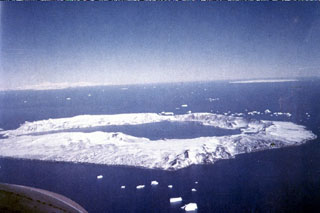Report on Deception Island (Antarctica) — February 1988
Scientific Event Alert Network Bulletin, vol. 13, no. 2 (February 1988)
Managing Editor: Lindsay McClelland.
Deception Island (Antarctica) Strong seismicity but no sign of recent eruption
Please cite this report as:
Global Volcanism Program, 1988. Report on Deception Island (Antarctica) (McClelland, L., ed.). Scientific Event Alert Network Bulletin, 13:2. Smithsonian Institution. https://doi.org/10.5479/si.GVP.SEAN198802-390030
Deception Island
Antarctica
62.9567°S, 60.6367°W; summit elev. 602 m
All times are local (unless otherwise noted)
International volcanological expeditions organized by the Instituto Antártico Argentino and the Vulcantar Project, Univ Nacional de Salta, visited Deception Island in January-February 1987 and 1988. Local and regional seismicity, thermal activity, and gas emission were monitored, and eruptive mechanisms were investigated, particularly for the 1842, 1967, 1969, and 1970 eruptions. Previous field work by Argentine scientists at Deception Island was during the austral summers of 1971-72, 1972-73, 1973-74, and 1974-75.
The 1988 expedition found no evidence of recent eruptions. Observers from Bellingshausen Base (USSR), 160 km NE, noted the possibility that a shallow submarine eruption could have occurred. Frequent small (mb 0.5) earthquakes were centered ~8 km from the expedition's base camp. These earthquakes were particularly numerous along the 5-km 1969 eruption fissure. Episodes of volcanic tremor with well-defined frequencies and durations of 5-40 minutes were also recorded. Strong regional earthquakes centered 40-80 km from Deception Island and possibly related to the extensive Mar de la Flota (Bransfield Strait) structure seemed to trigger local seismic activity. No significant differences between the 1987 and 1988 seismic data were observed. The distribution of fumarolic activity (90-100°C) was also unchanged. Gas emission was prevalent in the S portions of the main fissure systems on the island, while conductive processes seemed to explain the temperatures of surface water bodies in the N sector.
Geological Summary. Ring-shaped Deception Island, at the SW end of the South Shetland Islands, NE of Graham Land Peninsula, was constructed along the axis of the Bransfield Rift spreading center. A narrow passageway named Neptunes Bellows provides an entrance to a natural harbor within the 8.5 x 10 km caldera that was utilized as an Antarctic whaling station. Numerous vents along ring fractures circling the low 14-km-wide island have been reported active for more than 200 years. Maars line the shores of 190-m-deep Port Foster caldera bay. Among the largest of these maars is 1-km-wide Whalers Bay, at the entrance to the harbor. Eruptions during the past 8,700 years have been dated from ash layers in lake sediments on the Antarctic Peninsula and neighboring islands.
Information Contacts: J. Viramonte, Univ Nacional de Salta, Argentina; R. Ortiz Ramis, Museo Nacional de Ciencias Naturales, Spain; M. Martini, Univ di Firenze, Italy.

